Library of Congress's Blog, page 136
February 5, 2016
Pic of the Week: A Party of Pulitzers
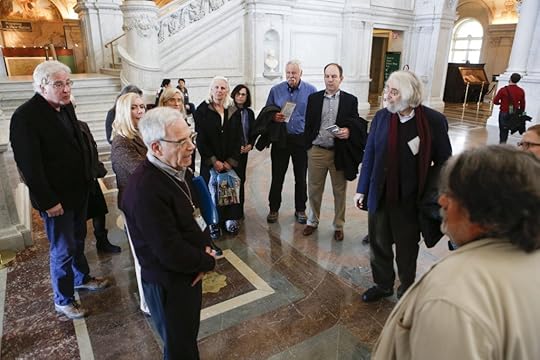
Docent Ira Adler (front left) escorts a group of Pulitzer Prize winners in the Great Hall last week. The recipients
were in Washington for the kickoff event of a yearlong celebration marking the prize’s centennial. Photo by Shawn Miller.
Thirteen Pulitzer Prize winners visited the Library last week while in Washington for festivities celebrating the esteemed award. Steve Benson, who won the prize for editorial cartooning in 1993; former U.S. Poet Laureate Rita Dove (poetry, 1987); Jennifer Egan (fiction, 2011); Paul Giblin (local reporting, 2009); Joan Hedrick (biography, 1995); David Levering Lewis (biography, 1994 and 2001); Jeffrey Marx (investigative reporting, 1986); Philip Schultz (poetry, 2008); Jane Smiley (fiction, 1992); Tracy K. Smith (poetry, 2012); T.J. Stiles (biography, 2010); Jonathan Weiner (nonfiction, 1995); and Michael York (investigative reporting, 1986). The group toured the Jefferson Building and sat for videotaped interviews.
Other Washington events — all part of a yearlong celebration for the prize’s centennial — included a special reception at the Newseum, where more than 300 prize winners were in attendance.
The Pulitzer Prizes were established by newspaper publisher Joseph Pulitzer in 1917 to honor high achievement in journalism, literature and musical composition in the United States.
February 4, 2016
Voices of White House Hopefuls
(The following is a story written by Mark Hartsell, editor of the Library of Congress staff newsletter, The Gazette.)
New Hampshire long has been a place where presidential hopes are born, revived and, sometimes, die.
New Hampshire is where Edmund Muskie famously cried, Ronald Reagan let everyone know who paid for that microphone, Bill Clinton declared himself the “Comeback Kid” and John McCain rode his “Straight Talk Express” into electoral contention.
As voters there prepare for the polls again, the American Archive of Public Broadcasting (AAPB) – a collaboration between the Library of Congress and the WGBH Educational Foundation – this week announced the acquisition of a radio-broadcast collection documenting candidates’ efforts to woo voters in the first-in-the-nation primary.
The New Hampshire Public Radio digital collection – almost 100 hours of content – covers campaigns from 1995 to 2007 and features a wide range of White House hopefuls: among others, Bill Clinton, Barack Obama, John McCain, Mitt Romney, Al Gore, Bob Dole, John Kerry, Joe Biden, Pat Buchanan, Steve Forbes and Hillary Clinton, both as first lady and as a presidential candidate.
That material, along with other presidential-campaign content from AAPB, is showcased in a new online exhibition, “Voices of Democracy: Public Media and Presidential Elections.”
“We are fortunate to live at the epicenter of the political universe every four years. It is from this vantage that we are able to capture and keep some of the most memorable and historic moments in the past 35 years of our democracy,” New Hampshire Public Radio President and CEO Betsy Gardella said. “Knowing that this archive can now be tapped and used by anyone with Internet access is an extension of our public service mission realized. We are grateful for the AAPB.”
The AAPB preserves and makes accessible the most significant public television and radio programs of the past 60 years – national and local news, local-history programs, programs exploring religion, education, music, art, literature and dance.
In October, the AAPB launched its Online Reading Room, featuring 2.5 million inventory records and more than 11,500 audiovisual streaming files of content dating to the early 1950s.
“The geographic breadth of the material available on the website will allow researchers to help uncover ways that national and even global processes – gender equality, economic cycles and environmental changes – played out at the local level,” said Alan Gevinson of the Motion Picture, Broadcasting and Recorded Sound Division, who manages the Library’s role in the project. “The long chronological reach, from the early 1950s to the present, supplies scholars, educators and the general public with previously inaccessible primary source material to document change over time.”
The New Hampshire material features presidential hopefuls announcing their candidacies, delivering stump speeches, submitting to interviews, hosting town halls and fielding questions from sometimes-skeptical listeners.
Obama, appearing on The Exchange call-in radio show in 2007, talked about “changing how politics is done in Washington” – prompting a listener to wonder if he was too “Pollyannaish” for office.
“I come out of Chicago politics – not known for being genteel,” Obama replied.
Bill Clinton, seeking re-election to the White House, staged a joint town hall with Newt Gingrich in 1995 – the first such event, Gingrich reckoned, ever to feature a sitting president and speaker of the House.
Before a delighted audience and a lone heckler, Clinton and Gingrich discussed balanced budgets, health-care reform, Medicare, four moose spotted on the road that morning and the pit stop for doughnuts Gingrich made before the event. “This is why you’ve done better with your figure than I’ve done with mine,” the speaker quipped.
“Voices of Democracy,” the online presentation created by Lily Troia of AAPB, features the New Hampshire material as well as interviews, speeches, debates, commentary and analysis spanning a much longer period, from 1961 to 2008.
Presidential candidate John F. Kennedy discusses proposals for the Peace Corps in 1960, human rights marchers protest the day before the 1964 Republican National Convention, Eldridge Cleaver speaks as the Peace and Freedom Party candidate in 1968, Iowa Public Television explores the role of the press in the primary process in “See How They Run.”
Some things change: All-white, all-male panels give way to more diverse groups, the clips of speakers smoking as they work gradually fade out.
But the concerns of voters, AAPB project manager Casey Davis said, largely remain constant, with the same issues coming up again and again.
“The material documents political process over the last 50 years at a time when people are getting ready to select the next leader of the United States,” Davis said. “We can look back at how these issues have been at the forefront of the voters’ consciousness for several decades now and at how far we have to go.”
February 1, 2016
Access to Knowledge
(The following story by Jennifer Gavin is featured in the January/February 2016 issue of the Library of Congress Magazine, LCM. You can read the issue in its entirety here.)
From MARC to metadata, the Library’s catalog records and expert staff provide access to a treasure trove of knowledge.
[image error]
A mural by Charles Sprague Pearce in the Library’s Thomas Jefferson Building. Carol M. Highsmith Archive, Prints and Photographs Division
In the beginning—that is, in 1800—the Library of Congress consisted of 740 books and three maps, all tucked into a room in the U. S. Capitol. Finding the right book, or map didn’t take long.
Today there are more than 162 million items in the collections available to researchers. Books and other printed materials numbered more than 38 million; there were 70 million manuscripts, 5.5 million maps, 14 million photos and nearly 2 million films. To discover and access these resources, researchers need a guide.
Often, it’s a research librarian—a modern day knowledge navigator—encountered in-person in one of the Library’s 20 reading rooms, or, for many, through the “Ask a Librarian” service online. Many an author whose work was researched at the Library of Congress will speak gratefully about the direction and extra effort delivered by such librarians to patrons, daily.
But even a trained research librarian has to know how to use a system to locate that particular book, serial title or other object in the great trove that is the Library of Congress.
Enter the Library’s catalogers—the great, unsung heroes and heroines of the knowledge delivery business. They stave off chaos and ensure access to knowledge by establishing order from the start.
“Catalogs”, “finding aids”, and “metadata” are all terms used to refer to the description of resources in the Library’s collection. “Description” itself is a broad term, referring to information about a resource’s physical properties as well as providing controlled name authority data about its creator and assigning subject headings and classification numbers to reflect its content. Catalogers create descriptions using internationally established
standards so that catalogs in the largest to smallest libraries can represent the same resource in the same manner.
Back in the day, the Library created and maintained vast handwritten, or typed cards stored in acreages of card catalogs—tall chests of specialized drawers that held indexing material used by researchers to locate books. Today, cataloging is computerized and the output is shared with other libraries, sometimes in multiple formats.
The move to automating catalog records was led by a seminal figure in library science, Henriette D. Avram, who joined the Library of Congress in 1965 and created the ARC (machine-readable cataloging) format. Avram, who was not formally trained as a librarian, had learned computer programming in an earlier job at the National Security Agency. But upon her arrival at the Library, she steeped herself in Library needs, knowledge and lore so she could determine what data would underpin MARC, a system that won worldwide adoption and earned Avram many awards, including some of the highest honors bestowed within library science.
MARC made it possible for cataloging data to be entered, accessed and stored on mainframe computers and shared cooperatively with partner libraries around the world.
To succeed the MARC format in the age of the semantic web and linked open data technologies, the Library of Congress is leading the effort to create a new bibliographic data carrier called the Bibliographic Framework Initiative. BIBFRAME will be a carrier for library data that will be shareable not only with other libraries that share the same systems, but on the World Wide Web through a semantic technology called linked open data.
BIBFRAME will open the world of bibliographic data to the linked open data world, making library data truly interchangeable in the web environment. The many years of effort the Library of Congress and its partners have put into creating thesauri and establishing authorized headings for creators can be redeployed and ultimately used to help “organize” the web as well as make library resources instantly findable through search engines for the users.
The Library’s catalog is freely available online. It includes references to resources in all formats and may provide links to materials that have been digitized. Interlibrary loan services are available to researchers from other libraries who find that the only copy of a material they need for their work is available at the Library of Congress.
Today, many books, newspapers, magazines, manuscripts, maps, films, photographs and other library materials are freely available on the web. Some 52.3 million digital files are available from the Library of Congress through its website and many are in the public domain.
“Digitization will become more and more extensive over time, and more books and other library materials are ‘born digital,’ said Beacher Wiggins, the Library’s director for acquisitions and bibliographic access. “Yet even when we digitize an item, we also maintain the original for its archival value.”
Whether you choose to access its resources in person or online, the Library of Congress is working to ensure that you will always be able to find the “it” you’re looking for in its vast collections.
[image error]
Elihu Vedder’s mosaic of “Minerva” on the second floor of the Thomas Jefferson Building depicts the goddess of wisdom and peace. Carol M. Highsmith Archive, Prints and Photographs Division
January 22, 2016
Pic of the Week: #MyTradition
In celebration of its 40th anniversary, the American Folklife Center at the Library of Congress (AFC) has launched year-long campaign asking Americans to share photos of their folk traditions. The campaign kicks off a year of events that will commemorate AFC’s four decades as the institution of record for American folk traditions and ensure that it remains the country’s most vibrant folklife archive and research center well into the future.

The Balkan singing group Slaveya performing at a National Folk Organization event. The group includes several Library of Congress employees, including AFC’s Theadocia Austen. For them, Balkan singing and costume are “MyTradition.” L-r: Anne Harrison, Katie Kathryn, Tzvety Weiner, Theadocia Austen, Betsy Smith Platt, Karen Chittenden and Helen Fedor. Courtesy of Theadocia Austen.
The photo campaign asks participants to share the photos to Flickr with the tag “MyTradition” and a Creative Commons license. Photos should highlight a folk tradition in which they themselves participate, creating a collective snapshot of folklife in 2016.
“Do you prepare a family recipe that goes back for generations? Do you sing, dance, tell stories, sew, quilt, craft, or make things by hand as part of a family, ethnic, regional, or occupational tradition? If so, we’d love your photos! We’re looking specifically for photos of a folklife tradition in which you participate yourself. The photo doesn’t necessarily have to include you, but that would be nice—and selfies are welcome,” said the AFC.
You can read more about folklife traditions and the #MyTradition initiative in this blog post from Folklife Today. Help the folklife center celebrate its 40th, and start sharing your photos!
January 20, 2016
He Came From the Near East
(The following is a guest post written by Anchi Hoh, a program specialist in the African and Middle Eastern Division.)
If you read last month’s Christmas-related blog post “An Armenian ‘Three Magi’ at the Library of Congress” by Levon Avdoyan, you may be wondering how the Library’s African and Middle Eastern Division acquired some of its collections. Avdoyan wrote that the Three Magi calligraphy sheet and other items were procured in the 1930s from Kirkor Minassian (1874-1944), a renowned dealer in fine Islamic and Near Eastern art, with establishments both in New York and Paris and who was an authority on Near Eastern manuscripts. One cannot answer the question of how the Library acquired some of its Near Eastern treasures without mentioning Minassian’s story and his importance to the nation’s library.
The prelude of this story was set in 1921 when the Declaration of Independence and the Constitution of the United States were transferred from the Department of State to the Library. The Library built a shrine to hold these two documents in the Great Hall of the Thomas Jefferson Building. These two documents were housed in the Library until 1941, when they were moved for safekeeping to the U.S. Bullion Depository at Fort Knox in Kentucky.
Sometime in the beginning of 1929, Minassian decided to make his first visit to the Library to pay homage to the two documents. This encounter was captured in the Annual Report of the Librarian of Congress 1929:
“His first visit to the Library of Congress, where he saw the originals of the Declaration of Independence and the Constitution of the United States in their specially constructed shrine, so impressed Mr. Kirkor Minassian, of New York City, that immediately upon his return to his home he sent us what proved to be the first of a series of gifts, totaling 90 separate items.”
This series of gifts started with mainly Arabic manuscripts, calligraphy sheets and clay tablets in the cuneiform writing of the Sumerian civilization. That very first visit by Minassian and his first group of donations to what he called “our Library of Congress” marked the beginning of his decade-long relationship with the Library.
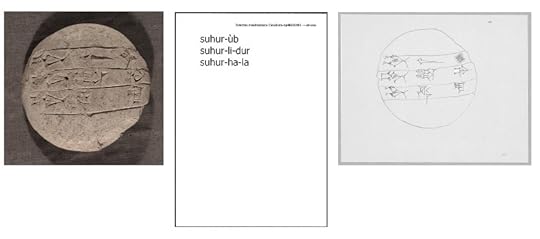
Cuneiform tablet no. 35. One of the 12 school exercise tablets, with transcription and drawing. Some of the tablets were probably used for teaching boys and girls in the temple schools of Sumeria (today’s southern Iraq). 2200-1900 B.C.
Herbert Putnam (1861-1955), then Librarian of Congress, described Minassian’s gifts as “striking examples and forms of literary, historical and artistic expression, which have been heretofore lacking in our collections and exhibits.” Putnam further said that the contribution of Minassian’s own initiative to the enrichment of the national Library was recognition of its aims and service.
The materials the Library acquired from Minassian were brought together over a period of 40 years during his numerous visits to the Near East, Egypt, Persia, Afghanistan, India and even to the borders of Tibet. In addition to his work dealing Near Eastern and Indian antiquities, Minassian maintained a personal collection of Islamic manuscripts, textiles, sculptural objects and ceramics. He was very generous in lending his personal collection for exhibition and publication purposes. The Art Institute of Chicago, the Morgan Memorial Museum in Connecticut and the Brooklyn Museum were among the institutions that exhibited his collection items.
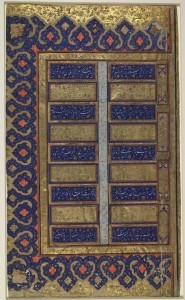
This single sheet of a Fal-i Qur’an (divination by the Quran) lays out in rhyming Persian distichs (couplets) the means of divination by letters selected at random when opening to a page of the Qur’an. 1550-1600.
Between 1930 and 1937, Minassian made a series of supplementary gifts of a related nature to the Library. Among these was a collection of manuscript treasures. This collection consists primarily of Arabic and Persian manuscripts, mostly single pages dating from the eighth to the 18th centuries, with material illustrative of Arabic and Persian calligraphy of different periods, as well as characteristic examples of Near Eastern book decoration and illumination.
The Library at the time did not have the means of acquiring any serious number of materials such as these and the then division of manuscripts had remained almost exclusively a collection of manuscripts illustrative of American history, politics, economics and culture. Minassian’s gifts thus represented a major landmark in the Library’s collection development history.
In 1931, Minassian placed in the Library as a loan his collection illustrating Near Eastern bookmaking. In preparation for an oriental bookmaking exhibition of these materials, he came personally to work with Library staff to unpack, sort, and prepare captions of exhibition materials.
The Library acquired this collection in 1937. It is a comprehensive collection of rare and original specimens of exquisite workmanship, pertaining to the development of writing and the book arts from the fourth to the 18th centuries in the Middle East. This remarkable collection covers an important field in the history of bookmaking. The Library could not have developed such a collection piecemeal.
Between 1929 and 1938, the Library also procured manuscripts and rare materials in English, French, Greek, and Latin from Minassian. But it was his collection of Near Eastern manuscripts and rare materials that laid a solid foundation for the continuing development of the Library’s Near Eastern collections. In 1938, the Library made a black and white photographic record of all the Near Eastern items, as well as some Indo-Persian manuscripts and handcrafts in the Minassian collection.
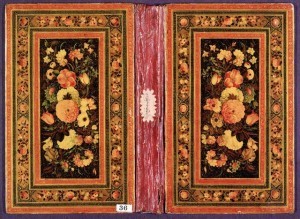
An elaborate display of brightly enameled flowers highlights this lush 18th-century Islamic book binding from the Kirkor Minassian collection.
In 1945, the Near Eastern manuscripts acquired from Minassian were supplemented by a corps of approximately 1,300 manuscripts and 3,700 books assembled by Shaykh Mahmud al-Imam al- Mansuri, professor of religion at the al-Azhar University in Cairo, purchased by the Library. Fast forward to the 1970s – after several Library reorganization efforts, the African and Middle Eastern Division was established in 1978 and has since become home to most of Minassian’s Near Eastern manuscripts. Today, the Minassian collection at the Library continues to be one of the finest in the world, and Minassian has become an indispensable part of the Library’s history.
January 15, 2016
Pic of the Week: Willie Nelson on PBS Tonight!
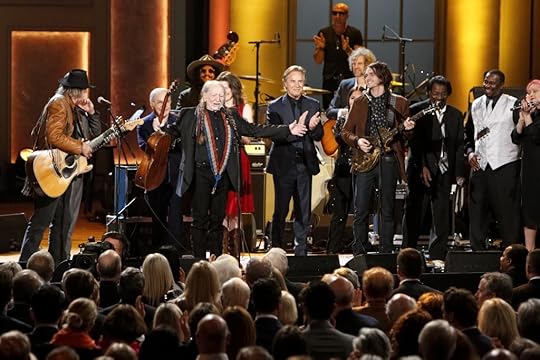
Willie Nelson receives a standing ovation at the conclusion of the 2015 Gershwin Prize for Popular Song concert at DAR Constitution Hall. Photo by Shawn Miller.
Make sure to tune in to PBS tonight for the star-studded concert tribute to Willie Nelson, the 2015 recipient of the Library of Congress Gershwin Prize for Popular Song. The concert airs on PBS stations nationwide at 9 p.m. ET on (check local listings). The program also will be broadcast at a later date via the American Forces Network to U.S. Department of Defense locations around the world.
This year’s all-star tribute features performances by Nelson, as well as Edie Brickell, Leon Bridges, Rosanne Cash, Ana Gabriel, Jamey Johnson, Alison Krauss, Raul Malo of The Mavericks, Neil Young, Promise of the Real, Buckwheat Zydeco and past Gershwin Prize honoree Paul Simon.
“Willie Nelson: The Library of Congress Gershwin Prize” is a co-production of WETA Washington, D.C., and Bounce, a division of AEG. The executive producers of the program are Dalton Delan, David Mao, Michael Strunsky and Mark Rothbaum.
Nelson is considered one of the top country singers of all time. His six-decade career has produced more than 200 albums and has earned him numerous awards and accolades as a musician, author, actor and activist. As a songwriter and performer, this iconic Texan became the voice of the heartland with such hits as “Crazy” and “Funny How Time Slips Away,” but he has continually pushed musical boundaries. He diversified his repertory and turned pop standards such as “Blue Skies” and “Mona Lisa” into country hits and such pop tunes as “Always on My Mind” and “To All the Girls I’ve Loved Before” into crossover favorites.
January 14, 2016
10 Stories: Mustaches in History! Chronicling America
In celebration of the release of the 10 millionth page of Chronicling America, our free, online searchable database of historical U.S. newspapers, the reference librarians in our Serials & Government Publications Division have selected some interesting subjects and articles from the archives. We’ve been sharing them in a series of Throwback Thursday #TBT blog posts.

So many mustaches: “Thirty Members of the Oregon House of Representatives,” Oregon Mist, Feb. 8, 1895.
Today we return to our historical newspaper archives for stories about the personal grooming choice that continues to take the hipster world by storm, the mustache. Proving once again that everything old is new (and vice versa), please enjoy these selections about the pros and cons of facial foliage.
“History of the Corps”
This article features Civil War Gen. Ambrose Burnside, remembered today for the lateral face-thatch to which he gave his transposed name, but who also sported some truly robust lip cover. The National Tribute (Washington, D.C.), Oct. 13, 1892.
“Modesty of the Average New Yorker”
In a sober assessment of the fashion of facial hair in the U.S., the New York Sun of June 11, 1905, notes that “The character of the American is shown in his distaste for anything spectacular in the way of a mustache” in a profusely illustrated article.
“Will Players Wear Whiskers?”
Apparently after a facial hair drought of some 15 years in the major leagues, a trio of Cleveland baseball players return from spring training bewhiskered. Here, Mr. Fullerton believes that the return of the mustache to baseball “will do some good.” Chicago Day Book, March 28, 1914.
“Ain’t Nature Wonderful?”
In the same publication two years later, an unnamed writer takes the opposing view, opening with “A mustache is an over-fed eyebrow,” and closing with “When the mustache becomes white, a beautiful autumn effect can be had by drinking coffee or by gnawing cut plug.” Ouch! Tell us how you really feel, sir! Chicago Day Book, September 16, 1916.
“Parisian Cafe Waiters and Their Mustaches”
Discrimination against mustaches was not limited to America. Apparently there was a fine of one dollar a day imposed upon professional waiters in French cafes when they began to show up to work with even the most perfectly-trimmed mustache. An outrage! Washington (D.C.) Evening Star, August 20, 1910.
“Club of Boomers of Mustache Meets in Boston”
Rallying against such rampant mustache-phobia, the aim of this gentleman’s dining club is to “increase the growth of mustaches on young men” (though it is unclear whether this means more mustaches or just bigger ones). “Today the lack of mustaches is largely due … to the wail of the scientist that ‘mustaches carry the greatest variety of germs and bacteria.'” The (White Earth, Minn.) Tomahawk, May 13, 1915.
“Whiskers and Their Virtues”
Unhealthy? Not so, says Henry Underwood in the Washington (D.C.) Times, May 12, 1907. “In whiskers there is health,” he notes, and, perhaps more importantly, “whiskers are claimed as a right under the Constitution.”
“When Whiskers Fell Before the Razor’s Onslaught”
The Omaha Daily Bee of Dec. 15, 1912, takes considerable umbrage at the epidemic of clean-shavedness among prominent Nebraskans. “Such a butchery of whiskers of all descriptions as has been going on in Omaha during the last ten to fifteen years is rivaled in cruelty only by the ruthlessness of Timur when he “built the ghastly tower of 80,000 human skulls.” Some exaggeration, perhaps, but the article includes many before-and-after photos to illustrate the point (about mustaches, not Timur).
“The Mustache as a Disguise”
A few twists and a bit of wax can apparently allow the appropriately-haired detective to skulk about in guises ranging from parson to anarchist to retired colonel to banana vendor. Ottumwa (Iowa) Tri-Weekly Courier, April 5, 1910.
“The Many Sided Man Who Will, In All Probability, Be Our Next President”
William Howard Taft was hardly the first president to sport a fine mustache, but few wore it as well as he did. He looks pretty sharp in a straw boater hat, too. New York Tribune, June 14, 1908.
[image error]
“There Are Only a Few of Us Left,” illustration by Charles Dana Gibson. San Francisco Call, May 25, 1913.
“There Are Only a Few of Us Left”
We close with an illustration by Charles Dana Gibson of a Civil War veteran who eschews the clean-shaven fashion of the day with this splendid ‘stache and beard. San Francisco Call, May 25, 1913.
For more mustache merriment, followers of our collections on Flickr have selected several of our photos there with the tag, “Great Mustaches of the Library of Congress” — and they do not exaggerate. The Flickr Commons, which we helped launch in 2008, celebrates its eighth anniversary on January 16.
Speaking of Chronicling America, the National Endowment for the Humanities (our partner in the project) has launched a nationwide contest, challenging you to produce creative web-based projects using data pulled from the newspaper archives website. We’re looking for data visualizations, web-based tools or other innovative web-based projects using the open data found on Chronicling America. NEH will award cash prizes, and the contest closes June 15, 2016.
Launched by the Library of Congress and the National Endowment for the Humanities (NEH) in 2007, Chronicling America provides enhanced and permanent access to historically significant newspapers published in the United States between 1836 and 1922. It is part of the National Digital Newspaper Program (NDNP), a joint effort between the two agencies and partners in 40 states and territories. Start exploring the first draft of history today at chroniclingamerica.loc.gov and help us celebrate on Twitter and Facebook by sharing your findings and using the hashtags #ChronAm #10Million.
Flickr Commons – Going Strong!
(The following is a guest post written by Helena Zinkham, chief of the Library of Congress Prints and Photographs Division.)

Golden Gate Bridge, San Francisco, California. Photo by Carol M. Highsmith, 2012. Prints and Photographs Division. View the photo in Flickr.
Join us for a “photo countdown” to January 16, which marks the 8th anniversary of the Flickr Commons. The theme is bridges, because the Commons has grown to connect historical and contemporary photographs from more than 100 different archives, libraries and museums.
The Library of Congress joined with Flickr to launch The Commons back in 2008, and the original invitation stands: “Please help make the photographs you enjoy more discoverable by adding tags and leaving comments. Your contributions and knowledge make these photos even richer.”
When we posted the Tower Bridges photo to Flickr this week, people quickly added dozens of subject tags to make it easier to find the image. In the comments, a detailed account of the bridge’s operation and a view of the surviving rolling lift mechanism as public art enriched the story.
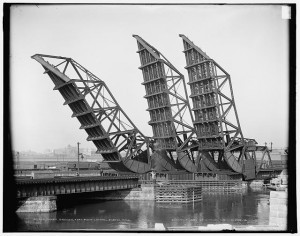
Tower bridges, Fort Point Channel, Boston, Mass. Photo by Detroit Publishing Co., 1904. Prints and Photographs Division. See photo in Flickr.
Most weeks, we post old news photographs that have incomplete and even erroneous titles. The steady addition of informative comments remains much appreciated, and we have folded almost 9,000 updated photo captions back into our own online catalog. The rapid deciphering of “Mystery Photos” that had no title at all is also very impressive!
Would you like to celebrate with us and explore the infinite possibilities of the Commons? All you need to do is visit The Commons and enjoy looking at the pictures and reading the stories. And, if you have a Flickr account, pick your eight favorite photos and tag them “Happy Birthday Flickr Commons.” Make a gallery of bridge photos and share the link through a comment. After all, “The key goal of The Commons is to share hidden treasures from the world’s public photography archives.”
Discover more:
Follow the countdown with the tag “Happy Birthday Flickr Commons”
Dip into Flickr highlights through the “Picture This” blog
Look at the variety of albums available through the Library of Congress Flickr account, and learn more about our Flickr project.

Red Jacket concrete bridge dedication, Minnesota. Aug. 22, 1911. Prints and Photographs Division. View the photo in Flickr.
January 13, 2016
Newly Acquired Arabic Manuscript on Early Astronomy and Mathematics
A table of relative dimensions of the extensions and retractions of planetary orbits, taken from “Tahrir al-Majisti,” by Nasir al-Din al-Tusi. African and Middle Eastern Division.
(The following is a guest post by Anchi Hoh, program specialist in the African and Middle Eastern Division.)The Library of Congress’s African and Middle Eastern Division recently added to its treasure trove a very important 15th century Arabic manuscript on astronomy and mathematics. “Tahrir al-Majisti” (“Commentary on the Almagest”), by Nasir al-Din al-Tusi, is part of the corpus of major commentaries by Muslim scholars on Ptolemy’s “Almagest,” many of which date back to the 8th century. In his treatise, al-Tusi challenges some of Ptolemy’s theories and reformulates the Ptolemaic planetary model, producing a system in which planets move in uniform circular motion.
Although the original work was written in 1247 by al-Tusi (1201-1274), this manuscript was probably produced in 1467 in Turkestan, in Central Asia. It is illustrated with numerous diagrams and tables in red and black ink and includes astronomical theorems, information on solar eclipses, descriptions of the movement of planets, the regressions of Mars and Mercury and attempts to measure the distance between the Sun and the Earth.
So who was Nasir al-Din al-Tusi?[image error]
A page regarding trajectories of planets from “Tahrir al-Majisti.” African and Middle Eastern Division.
Al-Tusi’s full name was Nasir al-Din Muhammad ibn Muhammad al-Tusi. A philosopher, astronomer and mathematician who knew Arabic, Persian and possibly Greek, al-Tusi was born in Tus (in today’s Iran) into a family of Shi’ite jurists. While raised in a religious environment, al-Tusi followed in his uncle’s footsteps and at a young age began studying science, including physics and mathematics. This laid the foundation for his scientific accomplishments in his later years.
Al-Tusi’s scientific journey started in Tus and flourished in Maragha (in today’s Azerbaijan). During his lifetime, the Mongol empire expanded from Beijing in the east to Europe in the west, and al-Tusi’s talents did not go unnoticed by the new rulers. First he served as a scientific advisor to the Mongol administration and then was put in charge of the ministry of religious bequests. Later he directed an observatory in Maragha. This observatory was his brainchild, which the then ruler, Hülegü Khan (c. 1217-1265), fully funded because of Hülegü’s belief in astrology.
Al-Tusi’s foresight also led to the inclusion in this facility of an excellent library and a faculty of notable Islamic and Chinese scholars. The Maragha Observatory, which was considered one of the greatest astronomical observatories of its day, continued to operate for many years until it fell into disrepair due to lack of funds, war and earthquakes.
The work done there represented a new wave of scientific research in the Islamic world in early medieval times and played a key role in the development of astronomy. The Maragha Observatory would become the model for several observatories that were subsequently built in Persia and Asia Minor up to the 17th century. Today in Azerbaijan a new observatory by the same name has been erected on the location where it is believed al-Tusi’s observatory once stood.
Approximately 150 works left by al-Tusi are known today, ranging from astronomy and mathematics to philosophy and theology. One of his most important works, “Tadhkira fi ‘ilm al-Hay’a” (“Memoir on Astronomy”), written later in his life, may be viewed through the Library’s online exhibition “Rome Reborn: The Vatican Library & Renaissance Culture.” The exhibit also contains several editions of Ptolemy’s “Almagest.”
[image error]Al-Tusi also invented a device, known today as the “Tusi Couple,” for generating linear motion along the diameter of the outer circle from two circular motions. This device enabled him to correct the Ptolemaic planetary models by proposing a system in which all orbits’ movements may be accurately predicted. Some believe that al-Tusi’s new theories may have been read by Nicolaus Copernicus (1473-1543) in the development of his sun-centered cosmological theories.
In addition to this latest acquisition, the African and Middle Eastern Division also houses a rich collection of Arabic science manuscripts as part of its 1,700 manuscript collection. The subjects of these science manuscripts in this collection include agriculture, arithmetic, medicine, astronomy, physics and time measurements. Some of these manuscripts have been digitized and are available to view via the Library of Congress Online Catalog and on the World Digital Library. [image error]
Among the digitized astronomy manuscripts are “Suwar al-kawākib” (“The Book of the Constellations of the Fixed Stars”), by ʻAbd al-Raḥmān ibn ʻUmar al-Ṣūfī (903-986), a Persian astronomer; and “Qāḍīʹzādah ʻalá al-Mulakhkhaṣ fī al-hayʼah” (“Commentary on “The Compendium of Plain Astronomy”),by Mūsá ibn Muḥammad Qāḍīʹzādah, an astronomer and mathematician born in Bursa (in today’s Turkey).
“Suwar al-kawākib” depicts celestial constellations and serves as an authority on Arabic names for the stars and constellations. Persian note before beginning of the text claims that the manuscript was created in 1417, but the note probably dates from the 18th century when the book was rebound. Published/created in the 17th century, “Qāḍīʹzādah ʻalá al-Mulakhkhaṣ fī al-hayʼah” is a treatise about theoretical astronomy by Maḥmūd ibn Muḥammad Jighmīnī (d. ca. 1221), a renowned Persian mathematician and astronomer.
January 8, 2016
Pic of the Week: Gene Luen Yang

Acting Librarian of Congress David Mao appoints Gene Luen Yang as the 2016-2017 National Ambassador for Young People’s Literature. Photo by Shawn Miller.
During a special ceremony yesterday, the Library welcomed comic book author and graphic novelist Gene Luen Yang as the National Ambassador for Young People’s Literature.
The National Ambassador is selected for his or her contributions to young people’s literature, the ability to relate to kids and teens, and a dedication to fostering children’s literacy as a whole. The selection is based on recommendations from a CBC-ECAR-CFB-appointed committee comprising educators, librarians, booksellers and children’s literature experts.
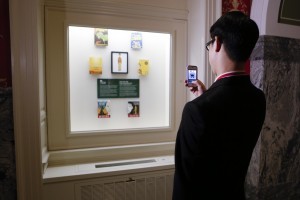
Gene Luen Yang looks over a display of his work outside the Library’s Young Readers Center. Photo by Shawn Miller.
Yang succeeds beloved and esteemed authors Jon Scieszka (2008-2009), Katherine Paterson (2010-2011), Walter Dean Myers (2012-2013) and Kate DiCamillo (2014-2015) in the position. Gene Luen Yang is the first graphic novelist and first Asian American to be named National Ambassador for Young People’s Literature.
Library of Congress's Blog
- Library of Congress's profile
- 74 followers



